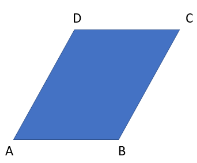Introduction
We come across several items of various shapes and sizes in our daily lives. Many items have three sides, whereas others have four, five, and so on. Some forms have equal sides on all sides, whereas others do not. Consider our laptop screen, deck of cards, tabletop, chessboard, carrom board, and kite as examples. What feature does each of these shares? Each of them has four sides.
A quadrilateral is a flat shape with four straight sides. The terms Quadra and Latus combine to make the word quadrilateral. Quadrilaterals are simply shaped with four sides since Quadra means “four” and latus means “sides” in Latin.
One definition of a quadrilateral is a closed four-sided shape. There are many different types of quadrilaterals, including square, rectangle, rhombus, trapezium, kite, etc., supported by the characteristics of sides and angles.
Quadrilaterals
A quadrilateral is a polygon with at least and at most four sides, four angles, and four vertices.
Just like every other polygon, except triangles, the quadrilaterals are also divided into two subcategories,
- Concave Quadrilaterals: These quadrilaterals have one diagonal passing through outside of the body of the quadrilateral. The following image shows one example of such quadrilateral

- Convex Quadrilaterals: These are the normal quadrilaterals, that have all the angles less than \(180^\circ \) , and both the diagonals are always contained within the quadrilaterals.
These are divided into \(2\) more categories
- Regular: In these quadrilaterals all four sides and all four angles are equal to one another. The only regular quadrilateral is Square.
- Irregular: In these quadrilaterals, all four sides or all four angles are not equal to one another. There are many irregular quadrilaterals, such as, Rhombus, Rectangle, Trapezium etc.
Properties in Quadrilaterals

Above, we have a quadrilateral \(ABCD\)
- This quadrilateral has \(4\) sides, and they are \(AB,BC,CD\) and \(DA\) .
- This quadrilateral has \(4\) vertices, and they are \(A,B,C\) and \(D\) .
- This quadrilateral has \(4\) angles one at each vertex.
Angle Sum Property of a Quadrilaterals
The Angle Sum Property of a Quadrilateral states that the sum of a quadrilateral’s four internal angles is \(360^\circ \) .
I.e., in above example of Quadrilateral ABCD, we have,
\[A + B + C + D = 360^\circ \]
Types of Quadrilaterals
In this section, we will discuss the different types of quadrilaterals and some of their properties.
 Square
Square
This is the regular quadrilateral, i.e., all four sides and all four angles are equal to one another. The diagonals are also equal, and bisect each other at right angles. By the property of regular quadrilateral and angle sum property, the angles of the square are right angles.
Rectangles
Rectangles have opposite sides equal and parallel, and all four angles in rectangles are right angles. The diagonals are equal, and they bisect each other but not at right angles.
Also Read: Exterior Angles of a Polygon
Rhombus
Rhombus’ have opposite angles equal, and all four sides in rhombus’s are equal. The diagonals bisect each other at right angles.
Parallelograms
Parallelograms have opposite sides equal and parallel, the opposite angles are also equal in a parallelogram. Diagonals bisect each other.
Trapezium
Trapeziums have only one property, i.e., they have one pair of opposite parallel sides. Other than that they can have any side lengths, any angles, and any diagonals.
Summary
This article taught us about quadrilaterals, including their kinds and qualities. A \(2D{\rm{ – }}shape\) with four sides, four vertices, and four angles is referred to as a quadrilateral. Quadrilaterals come in a variety of shapes, including rectangles, rhombus, squares, trapezoids, parallelograms, and kites. These all feature unique angles and side characteristics.
Frequently Asked Questions
1. Are all parallelograms rectangles? What about the other way around?
Ans. No, all parallelograms are not rectangles. Since to be a rectangle a parallelogram should have diagonals equal, they should also have all the angles to be right angles. Which is not the case for parallelograms. Whereas if we see it other way around, we have the pair of opposite sides parallel and equal to each other and the diagonals also bisect each other, thus all rectangles are parallelograms.
2. What are the properties of a kite?
Ans. Kite is a convex quadrilateral with pair of adjacent sides equal to each other and the diagonals are perpendicular to each other. Also, the diagonal between the equal sides bisects the other.
3. A square has the properties of all three, parallelogram, rectangle and rhombus. Justify this statement.
Ans. A square has following properties.
- Opposite sides parallel and equal. (Parallelogram)
- Opposite angles equal. (Parallelogram)
- Diagonals bisect each other. (Parallelogram)
- Diagonals are equal. (Rectangle)
- All the angles are equal to right angles. (Rectangles)
- All four sides are equal. (Rhombus)
- Diagonals are perpendicular bisectors of each other. (Rhombus)
Thus it is clear that the square has the properties of all, parallelogram, rectangles and rhombus.